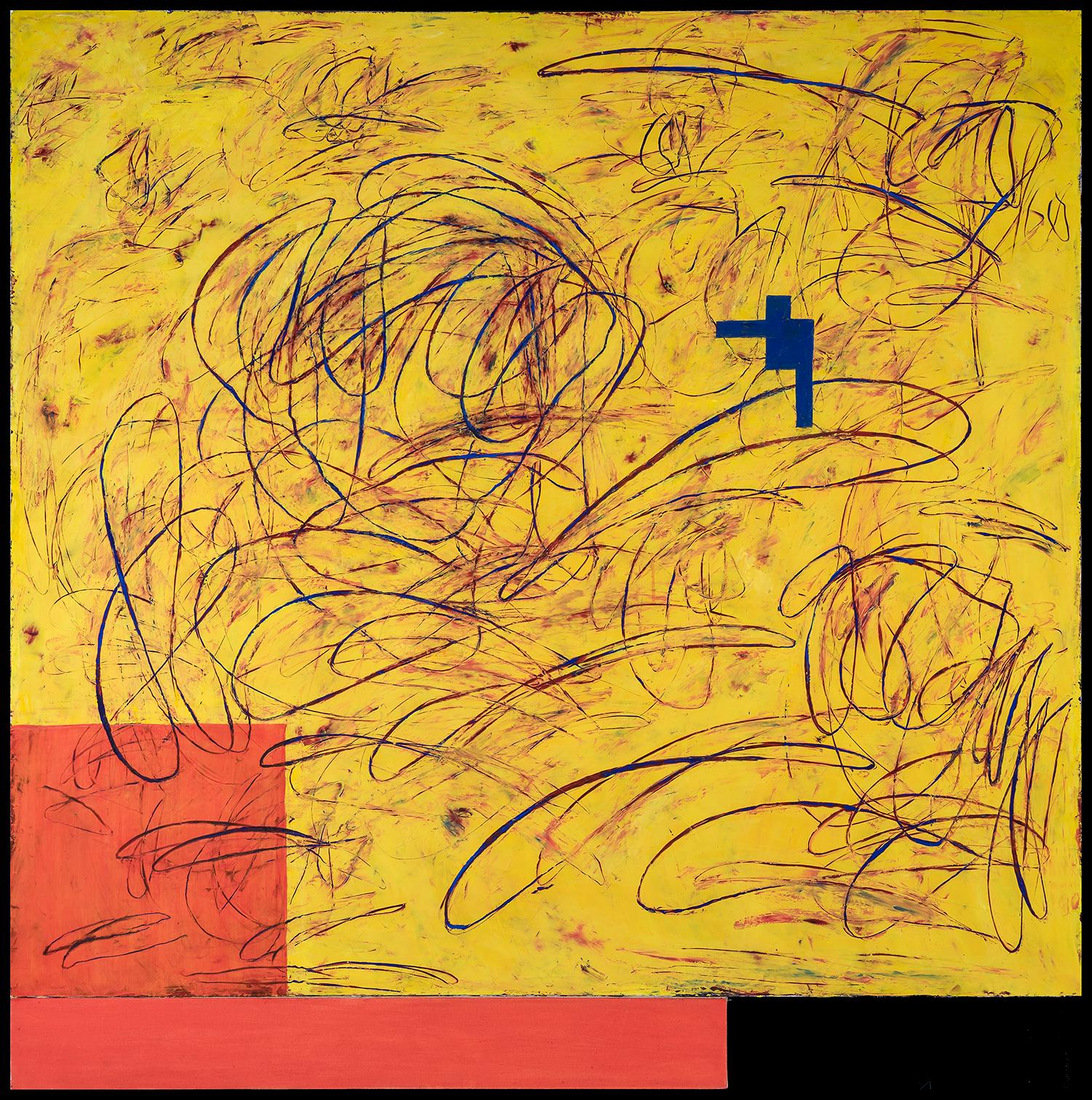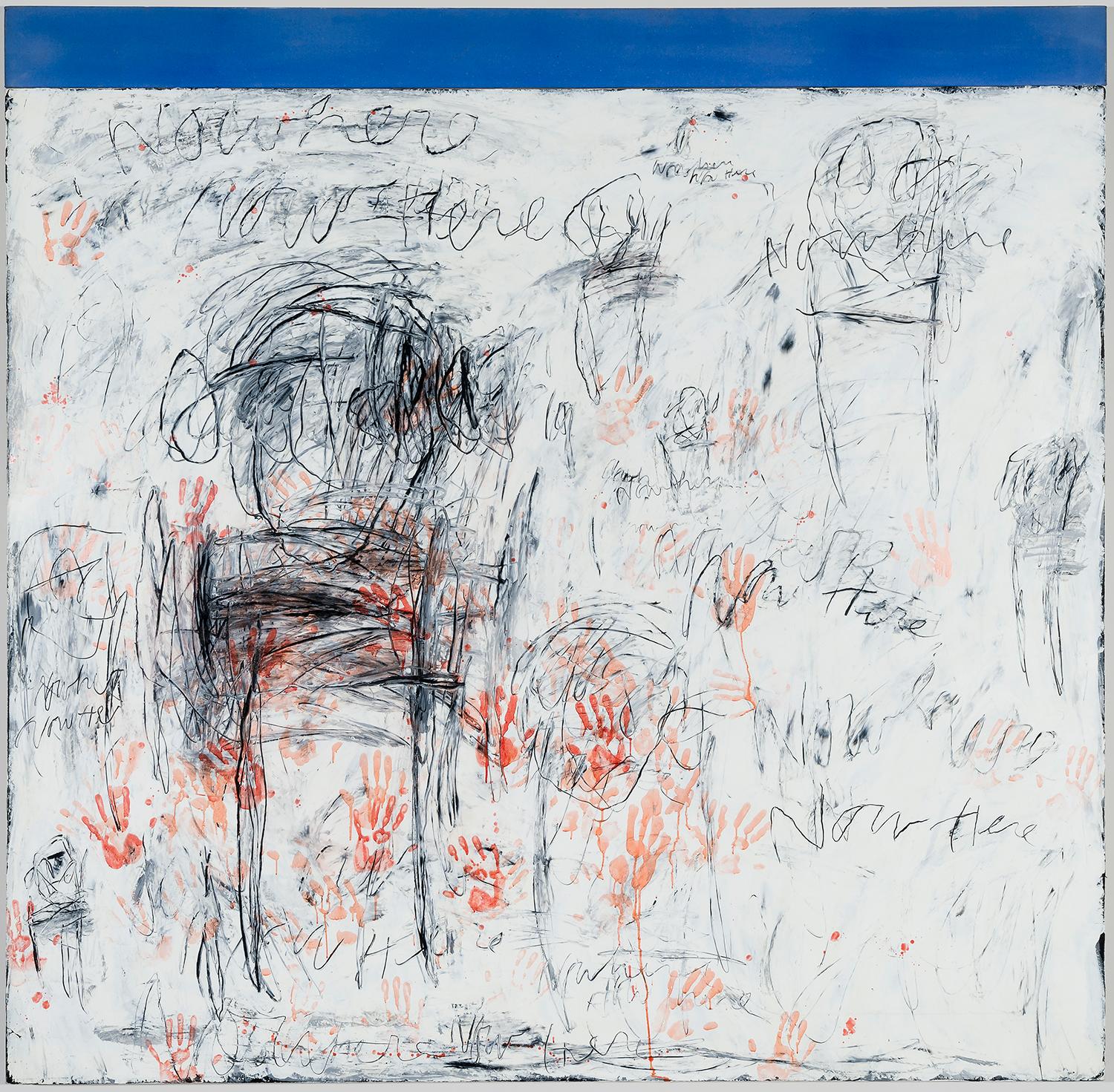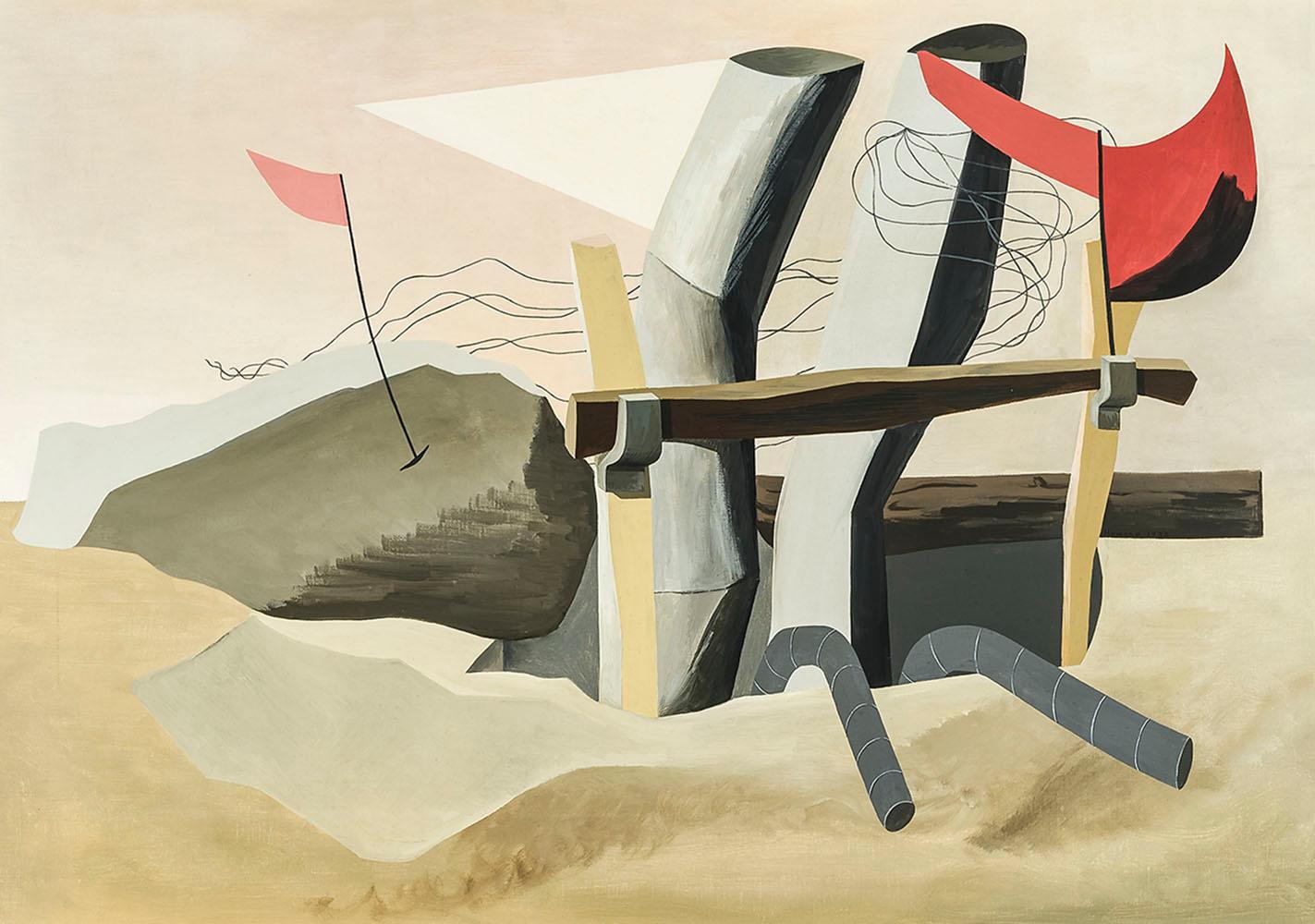Want more images or videos?
Request additional images or videos from the seller
1 of 10
John MarinStudy for Mid-Manhattan II1932
1932
About the Item
Study for Mid-Manhattan II
Oil and graphite on paper, mounted to board, 1932
Signed by the artist in pencil lower right
Sight size: 8 1/2 x 7 inches
One of a series of studies for the finished oil, "Mid-Manhattan II" as illustrated in Reich's John Marin: A Stylistic Analysis and Catalogue Raisonne (Tuscon: University of Arizona Press, 1970), nos. 32.23-32.24. (see photo)
Inscription in the artist's hand verso, with title, date and dimensions (see photo)
Provenance: Estate of the artist
Kennedy Galleries (agent for estate, see photo for label)
Christie's, Sept. 26, 1991 (label)
- Creator:John Marin (1870-1953, American)
- Creation Year:1932
- Dimensions:Height: 8.5 in (21.59 cm)Width: 7 in (17.78 cm)
- Medium:
- Movement & Style:
- Period:
- Condition:
- Gallery Location:Fairlawn, OH
- Reference Number:
About the Seller
5.0
Recognized Seller
These prestigious sellers are industry leaders and represent the highest echelon for item quality and design.
Platinum Seller
These expertly vetted sellers are 1stDibs' most experienced sellers and are rated highest by our customers.
Established in 1978
1stDibs seller since 2013
712 sales on 1stDibs
Typical response time: 1 hour
Associations
International Fine Print Dealers Association
- ShippingRetrieving quote...Ships From: Fairlawn, OH
- Return PolicyA return for this item may be initiated within 10 days of delivery.
More From This SellerView All
- #90 Strange CreatureBy Norbert LenzLocated in Fairlawn, OH#90 Strange Creature Oil and pencil on board, 1932 Signed and dated in the image lower right (see photo) Provenance: Joseph M. Erdelac, Cleveland, OH Condition: excellent Archival framing Image size: 10 1/2 x 11 3/4 inches Frame size: 25 x 24 inches Painter, illustrator and commercial artist Norbert Lenz was born in Norwalk, Ohio and received his artistic training at both the Huntington Polytechnic Institute and the Cleveland School of Art. During his career Lenz exhibited his paintings and drawings at such institutions as the Pennsylvania Academy of Fine Art, the Art Institute of Chicago, the Cleveland Museum of Art and the Butler Institute of American Art. Today the art of Norbert Lenz is held by the Columbus Museum of Art, the Cleveland Museum of Art and the Butler Institute of American Art. Lenz was also a very highly regarded commercial designer of stamps. He worked for a number of years at the House of Farman, a leading vendor of first day covers...Category
1930s American Modern Abstract Paintings
MaterialsOil
- Interieur No. IIBy Benjamin G. BennoLocated in Fairlawn, OHInterieur No. II Oil on canvas, 1937 Signed on verso (see photo) nscribed on reverse: Benno 1937 "Interieur" (No. II) 35 x 27 cm 9 rue Compagne Premiere Paris 14e Provenance: Estate of the artist Ruth O...Category
1930s American Modern Paintings
MaterialsCanvas, Oil
- PersephoneBy Virginia DehnLocated in Fairlawn, OHPersephone Oil on canvas, 1952 Signed lower left (see photo) Titled reverse "Persephone" Signed "V. 52" Exhibited: Columbus Gallery of the Arts label "71/30 Bt. 2", see label Condi...Category
1950s American Modern Abstract Paintings
MaterialsAcrylic
- PersephoneBy Virginia DehnLocated in Fairlawn, OHPersephone Oil on canvas, 1952 Signed lower left (see photo) Titled reverse "Persephone" Signed "V. 52" Exhibited: Columbus Gallery of the Arts label "71/30 Bt. 2", see label Condition: two very small flakes of missing paint Canvas size: 20 1/8 x 16" Frame size: 20 7/8 x 16 3/4" Provenance: Estate of the artist Dehn Heirs An important painting by the artist. Virginia Dehn From Wikipedia, the free encyclopedia Virginia Dehn (1922-2005) Virginia Dehn (née Engleman) (October 26, 1922 – July 28, 2005) was an American painter and printmaker. Her work was known for its interpretation of natural themes in almost abstract forms. She exhibited in shows and galleries throughout the U.S. Her paintings are included in many public collections. Life Dehn was born in Nevada, Missouri on October 26, 1922.] Raised in Hamden, Connecticut, she studied at Stephens College in Columbia, Missouri before moving to New York City. She met the artist Adolf Dehn while working at the Art Students League. They married in November 1947. The two artists worked side by side for many years, part of a group of artists who influenced the history of 20th century American art. Their Chelsea brownstone was a place where artists, writers, and intellectuals often gathered. Early career Virginia Dehn studied art at Stephens College in Missouri before continuing her art education at the Traphagen School of Design, and, later, the Art Students League, both located in New York City. In the mid-1940s while working at the Associated American Artists gallery, she met lithographer and watercolorist Adolf Dehn. Adolf was older than Virginia, and he already enjoyed a successful career as an artist. The two were married in 1947 in a private ceremony at Virginia's parents house in Wallingford, Connecticut. Virginia and Adolf Dehn The Dehns lived in a Chelsea brownstone on West 21st Street where they worked side by side. They often hosted gatherings of other influential artists and intellectuals of the 20th century. Among their closest friends were sculptor Federico Castellón and his wife Hilda; writer Sidney Alexander and his wife Frances; artists Sally and Milton Avery; Ferol and Bill Smith, also an artist; and Lily and Georges Schreiber, an artist and writer. Bob Steed and his wife Gittel, an anthropologist, were also good friends of the Dehns. According to friend Gretchen Marple Pracht, "Virginia was a glamorous and sophisticated hostess who welcomed visitors to their home and always invited a diverse crowd of guests..." Despite their active social life, the two were disciplined artists, working at their easels nearly daily and taking Saturdays to visit galleries and view new work. The Dehns made annual trips to France to work on lithographs at the Atelier Desjobert in Paris. Virginia used a bamboo pen to draw directly on the stone for her lithographs, which often depicted trees or still lifes. The Dehns' other travels included visits to Key West, Colorado, Mexico, and countries such as Greece, Haiti, Afghanistan, and India. Dehn's style of art differend greatly from that of her husband, though the two sometimes exhibited together. A friend of the couple remarked, "Adolf paints landscapes; Virginia paints inscapes." Virginia Dehn generally painted an interior vision based on her feelings for a subject, rather than a literal rendition of it.] Many of her paintings consist of several layers, with earlier layers showing through. She found inspiration in the Abstract Expressionism movement that dominated the New York and Paris art scenes in the 1950s. Some of her favorite artists included Adolf Gottileb, Rothko, William Baziotes, Pomodoro, and Antonio Tapies. Dehn most often worked with bold, vibrant colors in large formats. Her subjects were not literal, but intuitive. She learned new techniques of lithography from her husband Adolf, and did her own prints. Texture was very important to her in her work. Her art was influenced by a variety of sources. In the late 1960s she came across a book that included photographs of organic patterns of life as revealed under a microscope. These images inspired her to change the direction of some of her paintings. Other influences on Dehn's art came from ancient and traditional arts of various cultures throughout the world, including Persian miniatures, illuminated manuscripts, Dutch still life painting, Asian art, ancient Egyptian artifacts...Category
1950s American Modern Abstract Paintings
MaterialsAcrylic
- Arctic Light - Orange SunBy Karl ZerbeLocated in Fairlawn, OHArctic Light-Orange Sun Unsigned Gouache on Japanese fibrous paper Series: Tundra Paintings Exhibited: Karl Zerbe, Gouaches of the Artic Nordness Gallery, (Madison Avenue, NY) Feb 3 through Feb 23, 1958 Cat. No. 12 (label with work, see photo...Category
1950s American Modern Abstract Paintings
MaterialsGouache
- ChacoBy Virginia DehnLocated in Fairlawn, OHChaco Canvas, fabric, pigment and collage elements, 1985-1995 Signed lower left corner in red paint Title and signed in pencil on the verso on the top of the stretcher Condition: Excellent Canvas size: 18 x 18 inches Provenance: Estate of the Artist By descent Chaco is a Native American culture of Ancestral Puebloan peoples, thriving in New Mexico between 850 CE and 1250 CE. Some of the motifs in this work was inspired by Chaco Canyon wall art. This mixed media work was created after the artist moved from New York to Santa Fe in 1985. It combines many Southwestern and Native American motifs. This is one of a small group of similar works combing collage and mixed media. (See photo of native pictographs) that inspired this work. Virginia Dehn From Wikipedia, the free encyclopedia Virginia Dehn Virginia Dehn in her studio in Santa Fe Virginia Dehn (née Engleman) (October 26, 1922 – July 28, 2005) was an American painter and printmaker. Her work was known for its interpretation of natural themes in almost abstract forms. She exhibited in shows and galleries throughout the U.S. Her paintings are included in many public collections. Life Dehn was born in Nevada, Missouri on October 26, 1922.] Raised in Hamden, Connecticut, she studied at Stephens College in Columbia, Missouri before moving to New York City. She met the artist Adolf Dehn while working at the Art Students League. They married in November 1947. The two artists worked side by side for many years, part of a group of artists who influenced the history of 20th century American art. Their Chelsea brownstone was a place where artists, writers, and intellectuals often gathered. Early career Virginia Dehn studied art at Stephens College in Missouri before continuing her art education at the Traphagen School of Design, and, later, the Art Students League, both located in New York City. In the mid-1940s while working at the Associated American Artists gallery, she met lithographer and watercolorist Adolf Dehn. Adolf was older than Virginia, and he already enjoyed a successful career as an artist. The two were married in 1947 in a private ceremony at Virginia's parents house in Wallingford, Connecticut. Virginia and Adolf Dehn The Dehns lived in a Chelsea brownstone on West 21st Street where they worked side by side. They often hosted gatherings of other influential artists and intellectuals of the 20th century. Among their closest friends were sculptor Federico Castellón and his wife Hilda; writer Sidney Alexander and his wife Frances; artists Sally and Milton Avery; Ferol and Bill Smith, also an artist; and Lily and Georges Schreiber, an artist and writer. Bob Steed and his wife Gittel, an anthropologist, were also good friends of the Dehns. According to friend Gretchen Marple Pracht, "Virginia was a glamorous and sophisticated hostess who welcomed visitors to their home and always invited a diverse crowd of guests..." Despite their active social life, the two were disciplined artists, working at their easels nearly daily and taking Saturdays to visit galleries and view new work. The Dehns made annual trips to France to work on lithographs at the Atelier Desjobert in Paris. Virginia used a bamboo pen to draw directly on the stone for her lithographs, which often depicted trees or still lifes. The Dehns' other travels included visits to Key West, Colorado, Mexico, and countries such as Greece, Haiti, Afghanistan, and India. Dehn's style of art differend greatly from that of her husband, though the two sometimes exhibited together. A friend of the couple remarked, "Adolf paints landscapes; Virginia paints inscapes." Virginia Dehn generally painted an interior vision based on her feelings for a subject, rather than a literal rendition of it.] Many of her paintings consist of several layers, with earlier layers showing through. She found inspiration in the Abstract Expressionism movement that dominated the New York and Paris art scenes in the 1950s. Some of her favorite artists included Adolf Gottileb, Rothko, William Baziotes, Pomodoro, and Antonio Tapies. Dehn most often worked with bold, vibrant colors in large formats. Her subjects were not literal, but intuitive. She learned new techniques of lithography from her husband Adolf, and did her own prints. Texture was very important to her in her work. Her art was influenced by a variety of sources. In the late 1960s she came across a book that included photographs of organic patterns of life as revealed under a microscope. These images inspired her to change the direction of some of her paintings. Other influences on Dehn's art came from ancient and traditional arts of various cultures throughout the world, including Persian miniatures, illuminated manuscripts, Dutch still life painting, Asian art, ancient Egyptian artifacts...Category
1980s Abstract Abstract Paintings
MaterialsOil
You May Also Like
- UntitledBy Louisa ChaseLocated in New York, NYLouisa Lizbeth Chase was born in 1951 to Benjamin and Wilda Stengel Chase in Panama City, Panama, where her father, a West Point graduate, was stationed. The family moved to Pennsylv...Category
20th Century American Modern Abstract Paintings
MaterialsCanvas, Wax, Oil
- UntitledBy Louisa ChaseLocated in New York, NYLouisa Lizbeth Chase was born in 1951 to Benjamin and Wilda Stengel Chase in Panama City, Panama, where her father, a West Point graduate, was stationed. The family moved to Pennsylv...Category
20th Century American Modern Abstract Paintings
MaterialsCanvas, Oil
- Sunset GripBy Louisa ChaseLocated in New York, NYLouisa Lizbeth Chase was born in 1951 to Benjamin and Wilda Stengel Chase in Panama City, Panama, where her father, a West Point graduate, was stationed. The family moved to Pennsylv...Category
20th Century American Modern Abstract Paintings
MaterialsCanvas, Wax, Oil
- Nowhere, Now HereBy Louisa ChaseLocated in New York, NYLouisa Lizbeth Chase was born in 1951 to Benjamin and Wilda Stengel Chase in Panama City, Panama, where her father, a West Point graduate, was stationed. The family moved to Pennsylv...Category
1980s American Modern Abstract Paintings
MaterialsCanvas, Wax, Oil
- ExcavationBy Charles Houghton HowardLocated in New York, NYCharles Houghton Howard was born in Montclair, New Jersey, the third of five children in a cultured and educated family with roots going back to the Massachusetts Bay colony. His fat...Category
20th Century American Modern Abstract Paintings
MaterialsCanvas, Oil
- Untitled (Cubist Portrait)By Jerre H. MurryLocated in Los Angeles, CAThis work is part of our exhibition - America Coast to Coast: Artists of the 1940s Untitled (Cubist Portrait), 1945, oil on masonite, signed and dated lower middle, 20 x 16 inches, remnant of exhibition label verso, perhaps exhibited at Murry's solo exhibition at the Los Angeles's Screen Cartoonists' Gallery, July , 1945, presented in its original frame Jerre Murry was a California modernist painter. Born in Columbia, Missouri, Murry studied at the Detroit Academy of Art and worked as an artist for the Detroit News and Detroit Free Press. Murry traveled to the Bahamas, where he was inspired to paint modernist scenes of island life and people. By the early 1930s, Murry had relocated to Los Angeles, where he caught the attention of Synchromist painter Stanton Macdonald Wright, State Supervisor for the Federal Art Project (FAP) in Southern California. MacDonald Wright enrolled Murry into the FAP. Murry’s Gauguin-influenced painting Sun Image was exhibited together with other FAP artists at the Los Angeles County Museum of Art in 1936, and Murry was also included in the FAP exhibit at the Paris Exposition in 1937. Stendahl Galleries in Los Angeles, the Chamber of Commerce Gallery in Santa Barbara, and at the Los Angeles County Museum of Art also showed Murry’s work during the 1930s. Murry created a murals for Los Angeles Water & Power Company, the Boise, Idaho Post Office, and Glendale Junior College. In 1939, Murry's work was exhibited at the Golden Gate International Exposition and the New York World's Fair. He also was included in the All California Exhibition at the Los Angeles County Museum of art that same year. He went on to exhibit in Los Angeles at the Foundation of Western Art's Trends in Southern California Art shows in 1940 and 1941, at Raymond and Raymond Gallery in Hollywood and USC’s Elizabeth Holmes...Category
1940s American Modern Paintings
MaterialsMasonite, Oil
Recently Viewed
View AllMore Ways To Browse
Manhattan Photo
Framed Agent
Artist Marin
Arizona Photos
Vintage Arizona Photos
Flowers And Ocean
60s Painting Large
Motion Craft
Summer Greece
French Wall Hanging Painted
People Beach Unique
Blue Apples
Framed African Artwork
Mexican Modernist Painting
1960s Italian Oil
Landscape China Set
Texture Hanging Wall Art
Japanese Tv





